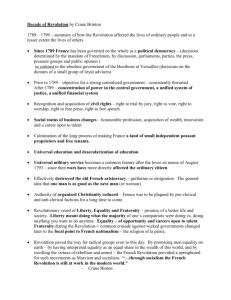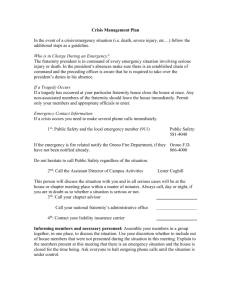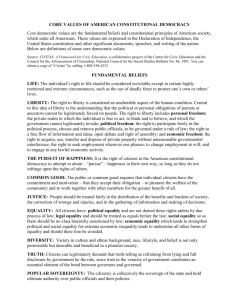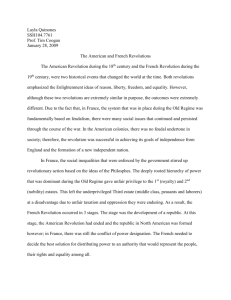Lesson 30 The French Revolution
advertisement
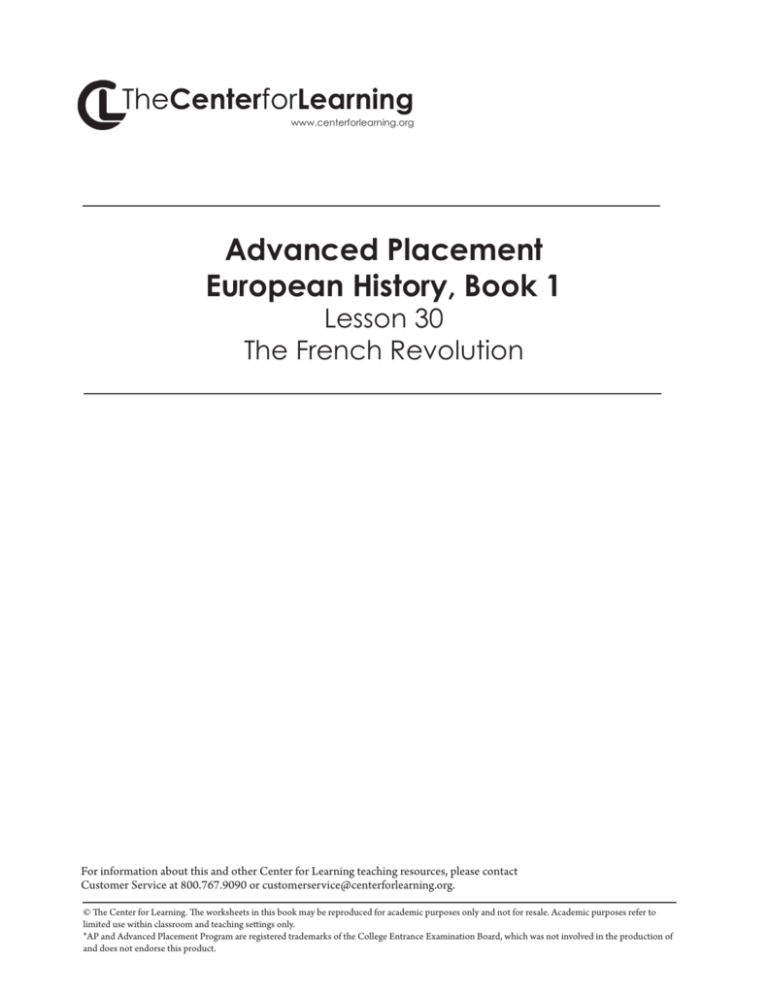
www.centerforlearning.org Advanced Placement European History, Book 1 Lesson 30 The French Revolution For information about this and other Center for Learning teaching resources, please contact Customer Service at 800.767.9090 or customerservice@centerforlearning.org. © The Center for Learning. The worksheets in this book may be reproduced for academic purposes only and not for resale. Academic purposes refer to limited use within classroom and teaching settings only. *AP and Advanced Placement Program are registered trademarks of the College Entrance Examination Board, which was not involved in the production of and does not endorse this product. Lesson 30 The French Revolution: Liberty, Equality, and Fraternity Procedure Objective • 1. Explain that the modern political theories of democracy, socialism, communism, and fascism have their roots in the ideals of the French Revolution. Explain that these theories developed as a result of conflict between liberals and conservatives that is still ongoing. To consider the concepts of liberty, equality, and fraternity as defined by the French Revolution Notes to the Teacher The French Revolution was the most shattering revolution of modern times. It unleashed a Pandora’s box of troubles, but also brought into focus the concepts of liberty, equality, and fraternity. These ideals have been championed and opposed by radicals and reactionaries, liberals and conservatives, and the left and the right. This conflict gave rise to most of the isms of the nineteenth and twentieth centuries. Most modern political philosophies, such as democracy, socialism, communism, and fascism, have their origin in the flow and counterflow of events and movements surrounding the French Revolution and its concepts of liberty, equality, and fraternity. 2. Distribute Handout 49, and have students complete part A. Review responses. Suggested Responses: 1. a. Liberty—the possession and free exercise of self-government b. Equality—the condition of enjoying equal political, economic, and social rights c. Fraternity—brotherhood 2. a. Count of Artois Government—The role of government is to rule the people with absolute firmness in the style of Louis XIV. The seeds of these ideas were written into the Code Napoleon and moved across Europe, where they took root among the middle and lower classes. Hope for change and a better society became the motivating force of European culture. The conservative looked back to the old society of birthright, while the liberal looked forward to a society of talent. The French Revolution placed in motion this liberal/conservative conflict and fed it into the mainstream, where it became a permanent fixture of western civilization. Social classes—The accepted division of society into three estates should be maintained. Justice and law—Different laws should apply to different classes, and the higher classes should be exempt from certain restrictions. b. Madame Roland Government—A limited monarchy is the best form of government. In this lesson, students write their own definitions of liberty, equality, and fraternity, based on an understanding of five representative characters of the French Revolution that they have researched, and complete questions for discussion. In order to develop a better sense of the chronology of the Revolution, they associate major events of that time with the development of the concepts of liberty. equality, and fraternity. In conclusion, students develop a thesis defining liberty, equality, and fraternity, based on the events and thought of the French Revolution. Social classes—The social class distinction between the nobility and middle class must be eliminated; however, complete equality of all classes is merely a dream. Justice and law—The same laws should apply to all Frenchmen, and justice should be meted out on this basis. 207 From Advanced Placement European History, Book 1. Copyright © The Center for Learning (www.centerforlearning.org). Not for resale. c. 3. Divide students into groups of four or five to complete part B. Review responses. Robespierre Government—A republican form of government is best, and the best republican government is one run by people sharing his political views. Suggested Responses: 1. a. Count of Artois Liberty—Liberty is the privilege of birth. Social classes—All social classes are equal in theory; however, the nobles and non-juring clergy as well as all of his opponents should be eliminated. Equality—People are equal within their classes. Fraternity—The nobles of France are fraternally allied with the aristocrats of Europe but not with their fellow Frenchmen. Justice and law—Law is meant to control anti-revolutionary forces. d. Member of the Directory b. Madame Roland Government—Government should be controlled by the middle class to insure law and order. Liberty—Liberty is defined in terms of wealth. Equality—All people are created equal, but some are more equal than others. Social classes—Theoretically, all people are equal; but it is in the best interests of France for the business and military interests to dominate. Fraternity—The glory of France is the brotherhood of man. Justice and law—Law is meant to restrain the violent segments of society. c. Liberty—Liberty should be granted to all citizens, especially those who favor his views. e. Napoleon Government—Government should be centralized in the hands of a single person. Equality—Equality must be enforced even to the extent of eliminating those in opposition. Social classes—The military and upper classes should determine the best course for the nation. Fraternity—All Frenchmen must work together to continue the ideals of the Revolution. Justice and law—Equality before the law and the concept of guilty until proven innocent are fundamental legal principles of France. 3. a. 4 l. c. 10 m. 5 d. 19 n. 2 e. 15 o. 18 f. p. 16 14 d. Member of the Directory Liberty—Liberty is defined in terms of wealth. k. 11 b. 7 Equality—All people are created equal, but some are more equal than others. 13 g. 1 q. 9 h. 6 r. i. 3 s. 20 j. 12 t. Robespierre Fraternity—The ideal of fraternity must be maintained, but it must be constrained by law and order. e. Napoleon Liberty—Liberty is a freedom for people who follow the laws and dictates of the government. 8 17 Equality—All people are created equal, and the equality of talent is a government strength. 208 From Advanced Placement European History, Book 1. Copyright © The Center for Learning (www.centerforlearning.org). Not for resale. 5. To conclude, have students complete part D as a large-group activity. Review responses. (There is no single definition for this concept from the French Revolution, and its ultimate explanation depends on the circumstances of the times.) Fraternity—Fraternity is patriotism, and patriotism is the basis of a strong government. 2. fraternity 3. Robespierre and Napoleon 4. Have students complete part C of the handout individually. Review responses. Suggested Responses: 1. Count of Artois—None 2. Madame Roland—Tennis Court Oath, Fall of the Bastille, Night of August 4, Declaration of the Rights of Man, Civil Constitution of the Clergy, Mirabeau’s constitutional monarchy, Brunswick Manifesto, abolition of the monarchy 3. Robespierre—“Marseillaise,” Reign of Terror, national conscription (Decree of Levée en Masse), metric system, tricolor, Committee of Public Safety 4. Member of the Directory—White Terror, Thermidorean Reaction 5. Napoleon—Consulate, Code Napoleon, Concordat of 1801, Napoleon crowned Emperor 209 From Advanced Placement European History, Book 1. Copyright © The Center for Learning (www.centerforlearning.org). Not for resale. Advanced Placement European History, Book 1 Lesson 30 Handout 49 (page 1) Name_______________________ Date________________________ Ideals of Liberty, Equality, and Fraternity Part A. Directions: Answer the following questions. Be prepared for class discussion. 1. Write your own definition of each of following terms. a. Liberty b. Equality c. Fraternity 2. Research the Count of Artois (later King Charles X), Madame Roland, Robespierre, a member of the Directory, and Napoleon. Note how each of these viewed government, social classes, and justice and law. Person Government Social Classes Justice and Law a. Count of Artois b. Madame Roland c. Robespierre d. Member of the Directory e. Napoleon © COPYRIGHT, The Center for Learning. Used with permission. Not for resale. 210 Advanced Placement European History, Book 1 Lesson 30 Handout 49 (page 2) Name_______________________ Date________________________ 3. Place the following items in the correct chronological order. _______a. Declaration of the Rights of Man _______l. _______b. Brunswick Manifesto _______m. Civil Constitution of the Clergy _______c. National conscription _______n. Fall of the Bastille _______d. Concordat of 1801 _______o. Code Napoleon _______e. White Terror _______p. Thermidorean Reaction _______f. _______q. “Marseillaise” Reign of Terror Committee of Public Safety _______g. Tennis Court Oath _______r. _______h. Mirabeau’s constitutional monarchy _______s. Napoleon crowned emperor _______i. Night of August 4 _______t. _______j. Tricolor Abolition of the monarchy Consulate _______k. Metric System Part B. Directions: Complete the chart and answer the questions. 1. Define liberty, equality, and fraternity according to the views of each of the following people. Person Liberty Equality a. Count of Artois b. Madame Roland c. Robespierre d. Member of the Directory e. Napoleon © COPYRIGHT, The Center for Learning. Used with permission. Not for resale. 211 Fraternity Advanced Placement European History, Book 1 Lesson 30 Handout 49 (page 3) Name_______________________ Date________________________ 2. Which is most emphasized—liberty, equality, or fraternity? 3. Which person represents the period that was most constructive for the development of these human rights? 4. With which of the above would your views on liberty, equality, and fraternity be most closely related? Part C. Directions: Link the events from item 3 of part A with the appropriate person. 1. Count of Artois 2. Madame Roland 3. Robespierre 4. Member of the Directory 5. Napoleon Part D. Directions: Develop a thesis on the ideals of liberty, equality, and fraternity, based on the events of the French Revolution. © COPYRIGHT, The Center for Learning. Used with permission. Not for resale. 212
